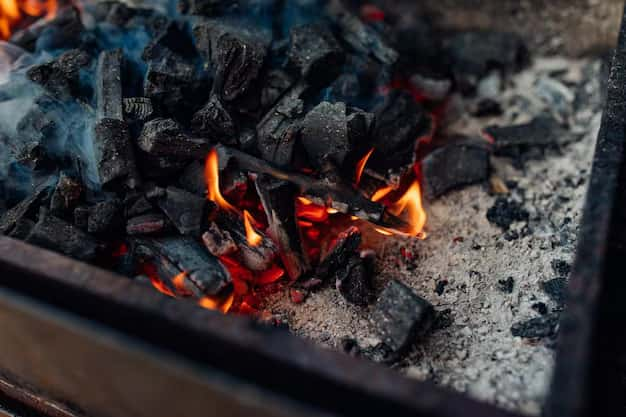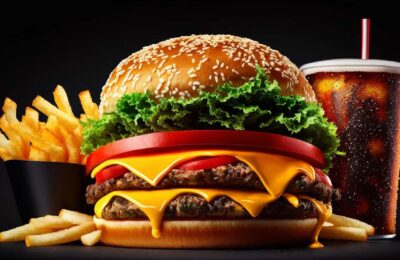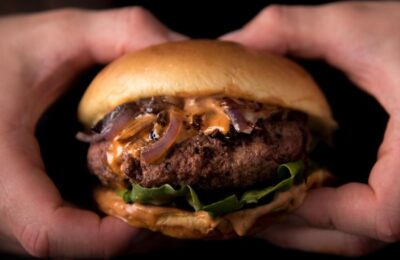Understanding the art of grilling is like learning a delightful new language, where food, fire, and flavors intertwine to create symphonic BBQ experiences. One of the fundamental elements in this language is charcoal. Getting the right amount of charcoal can make the difference between a memorable, mouth-watering meal and an unfortunate cooking misstep.
Let’s master this!
Factoring in Grill Size, Cooking Temperature, and Food Type
The amount of charcoal needed for grilling is influenced significantly by the size of your grill, the temperature you aim to cook at, and the type of food on the menu. Here’s a simple guideline to follow:
- For standard-sized grills, begin with 2-3 pounds, which approximately equates to 30-40 briquettes. This is a general recommendation suited for most cooking scenarios;
- Adjustments can be made depending on specific requirements. For instance, you might need more charcoal for longer cooking durations or unique grilling techniques’
- Always ensure your grill has even heat distribution. You can achieve this by arranging your charcoal effectively;
- It’s essential to monitor the grill’s temperature consistently. Too high, and you risk burning your food; too low, and your meal could remain uncooked or lose its juicy flavor.
The Charcoal Dance: Walking the Fine Line
Grilling is an art and a science where BBQ lovers learn to dance with the flames. And one of the most crucial steps of this dance is understanding how much charcoal to use. Too little charcoal could leave you with raw, flavorless food, while too much could burn your precious ingredients to a crisp.
Ensuring you strike the perfect balance with your charcoal usage can be a game-changer for your BBQ sessions. It may seem like a small piece of the puzzle, but it’s fundamental to your grilling success.
Mastering the Art of Charcoal Measurement: A Guide
Part of the grilling mastery involves learning to gauge the ideal charcoal quantity for your food. This guide aims to equip you with the insights needed to make this crucial decision confidently. Let’s delve into the details:
- Be Observant: The first step towards mastering charcoal measurement is observational learning. Notice how the charcoal affects your food—the cooking times, the flavor, and the appearance. This will help you gauge the amount needed for future occasions;
- Trial and Error: Like all skills, this too relies on practice. Don’t be discouraged by initial mistakes. Instead, view each grilling session as an opportunity to understand charcoal management better;
- Research and Learn: Seek advice from experienced grillers, read books on BBQ techniques, and watch online tutorials. The more knowledge you gather, the better your grilling skills will become.
Exploring the World of Charcoal: Different Types and Their Unique Characteristics
The grilling experience is significantly influenced by the kind of charcoal used. Each variant possesses distinct characteristics that enhance heat consistency, flavor, and burn duration. Let’s delve deep into the primary types of charcoal available:
Lump Charcoal: The Raw Authenticity
Lump charcoal, essentially pieces of hardwood turned into char, is as natural as it gets.
Advantages:
- Quick Ignition: Lump charcoal lights up much faster compared to other forms;
- High Heat: It burns at higher temperatures, offering an intense grilling environment;
- Authentic Flavors: The genuine wood flavor it adds to the food is a gastronomical delight.
Drawbacks:
- Rapid Burnout: Lump charcoal tends to burn out faster, reducing the grilling duration;
- Size Variability: The chunks come in different sizes, making it somewhat challenging to determine the precise amount required.
Charcoal Briquettes: The Consistent Performer
Charcoal briquettes are compressed blocks made from a blend of charcoal dust, binders, and various fillers.
Advantages:
- Consistent Burn: They offer a predictable burn rate, providing stability during grilling;
- Uniform Size: Briquettes’ standard size aids in maintaining steady temperatures and calculating the quantity needed.
Drawbacks:
- Potential Additives: Certain briquettes may contain additives that could alter the food’s flavor. Thus, always check the label and choose natural, additive-free options.
Specialty Charcoals: The Flavor Enhancers
Apart from the traditional charcoal forms, there are a few specialty variants available:
- Flavored Briquettes: These briquettes are infused with flavors like mesquite or hickory, adding an extra layer of taste to grilled dishes;
- Coconut Shell Charcoal: Crafted from coconut shells, this is a more environmentally friendly option. These charcoals produce minimal ash and have a unique flavor profile.
Unraveling the Determinants of Charcoal Quantity: A Comprehensive Guide
The grilling process is a complex interplay of multiple elements—each holding significance and influencing the outcome. While charcoal is a vital component, determining its ideal quantity is not straightforward. Several factors come into play, which we’ll explore in detail:
Grill Dimensions and Design: Understanding the Impact
The size and design of the grill wield a substantial influence on charcoal consumption. For instance, a petite, portable grill, designed for on-the-go grilling experiences, demands much less charcoal than a sprawling backyard grill setup. However, it’s not just about size; grill design matters too. Grills with thicker walls or superior insulation excel at retaining heat, thereby leading to more efficient fuel consumption.
Aspiring for the Perfect Cooking Temperature: A Balancing Act
The art of grilling involves juggling different temperatures based on what’s cooking. For example, searing a succulent steak necessitates high heat, translating into more charcoal usage, while slow-cooking tantalizing ribs at a lower temperature might demand less. It’s about understanding your cooking objectives and adjusting the charcoal quantity accordingly.
The Time Factor: Accounting for Grill Duration
The length of your grilling session is another determinant for the amount of charcoal required. Quick grilling endeavors, such as burgers or crunchy veggies, are satisfied with a small amount of charcoal. However, more extended grilling tasks, like smoking a flavorful brisket, need a steady, prolonged heat source, implying more charcoal. It’s always a smart move to reserve some extra charcoal, ready to keep the fire going if needed.
Food Characteristics: Playing the Role of a Decisive Factor
Just as a chef adjusts ingredients based on the dish, a griller must vary the charcoal volume depending on the food type. Thick, hearty cuts of meat or whole poultry require sustained heat, implying a higher charcoal volume. In contrast, more delicate fare like flaky fish or thin vegetable slices are cooked quickly, minimizing the fuel requirement.
Demystifying Charcoal Management: A Comprehensive Guide
The art of grilling lies in the subtle mastery of heat management. Every BBQ enthusiast faces the eternal question: how much charcoal is enough? The journey to understanding this critical aspect can be daunting, with chances of over-intense heat leading to charred outcomes or insufficient heat resulting in undercooked disappointments. It is vital to gear up with one of the top-rated charcoal grills for optimum results.
Over time, certain general rules can be adapted and tweaked to individual grilling styles and requirements. Let’s unravel them:
A Starting Point:
For a standard kettle grill, a practical starting point is to form a single layer covering the grill’s bottom. This is approximately around 2-3 pounds or about 30-40 briquettes. Suitable for most casual grilling sessions, consider this quantity as a baseline.
Adjusting for Grill Size:
The grill size can notably influence charcoal quantity. For instance, a larger, barrel grill could demand double the charcoal compared to a smaller variant. It’s essential not only to fill the grill but also to spread the charcoal evenly to ensure uniform heat distribution.
Balancing High Heat vs Low Heat:
High-heat searing, required for dishes like steaks or burgers, may need additional briquette handfuls. This increment helps in reaching and maintaining the high temperatures throughout the cook. Conversely, slow-cooked dishes or smoking may necessitate slightly less than the baseline amount, focusing on sustaining a steady, low heat over extended periods.
Duration Counts:
Quick, 15-minute grilling sessions can generally make do with the baseline charcoal quantity. However, for longer BBQ ventures, it’s wise to keep extra charcoal on standby. Running out of heat midway while grilling a delicious rack of ribs can be disappointing. If long, slow cooking is the mainstay, a charcoal smoker may be a better alternative than a grill.
Experimentation and Learning:
While the guidelines offer a useful framework, the art of grilling also demands a fair degree of experimentation. Various charcoal brands burn at different intensities and durations. Consequently, measurements may need tweaking based on the specific charcoal at hand.
Keeping a Grilling Diary:
One effective strategy is to maintain a grilling journal detailing the charcoal quantity used, the food type, cooking duration, and general observations each time you light up the grill. Over time, this becomes a valuable repository of personalized insights, enabling the refinement of charcoal usage.

Decoding Charcoal Measurement: Effective Techniques for Ideal Grilling
Perfecting the art of grilling depends significantly on mastering the delicate balance of charcoal management. An essential part of this process lies in identifying accurate techniques to measure charcoal quantity. Each method carries its unique set of advantages, offering a spectrum of options for grill masters to choose from, based on individual preferences and grilling requirements. Let’s dive into some of these effective techniques:
The Charcoal Chimney: A Griller’s Best Friend
A charcoal chimney is a powerful tool for both lighting charcoal and measuring its quantity. Its design ensures a uniform, efficient burning process, and the volume it initially carries serves as an effective gauge for charcoal measurement. Generally, a completely filled charcoal chimney provides enough fuel for high-heat grilling sessions on a standard kettle or 2-burner gas grill. For lower temperature requirements or short-duration grilling, half a chimney usually suffices.
The ‘Handful’ Approach: Simplifying Measurements
When a chimney isn’t readily available, the ‘handful’ method is a useful alternative. This involves estimating the charcoal quantity based on average handful sizes. Typically, three to four handfuls form an adequate starting point for most grilling situations. While this method might not be as precise as others, it offers convenience and speed, especially for grillers who are familiar with their grilling setup.
The Precision of Weighing: For Grilling Perfection
The commitment to achieving the ideal grilling conditions often leads some grillers to adopt highly precise methods such as weighing the charcoal. Using a standard kitchen scale, they can measure the exact charcoal quantity required for their grilling session. Although this approach may seem excessive to some, it offers unmatched control, especially when grilling dishes that demand highly specific temperature conditions.
Visual Estimation: Leveraging Experience
As grillers become more seasoned, their ability to visually estimate charcoal quantity improves. This method involves spreading the charcoal in a single layer at the grill’s base or stacking it to a predetermined height. Honed over time, this approach often becomes the first choice for experienced grillers, especially during unplanned BBQ get-togethers.
On-the-Fly Adjustments: Trusting Instincts
Beyond all techniques and methods, grilling is an intuitive process. There may be grilling sessions where, irrespective of the initial measurements, grillers might feel the need to adjust the charcoal quantity mid-way. Acute observations, experience, and instincts play a crucial role in these on-the-fly adjustments, often leading to exceptional grilling outcomes.
Adjusting Charcoal for Cooking Techniques
Grilling is understood to be a diverse activity, requiring different approaches for various dishes and cooking techniques. Mastery in grilling involves recognizing the need to adjust charcoal layout and quantity depending on the desired outcome. The following insights offer a glimpse into various grilling experiences:
Direct vs. Indirect Grilling:
A key distinction in grilling techniques is between direct and indirect grilling. In direct grilling, where food is cooked directly over the flames (such as burgers or steaks), charcoal is spread evenly across the grill’s base to provide uniform heat, ideal for quick-cooking items.
Conversely, indirect grilling is used for larger cuts of meat or dishes needing longer cooking times. In this method, charcoal is piled on one side of the grill, creating a hot zone and a cooler zone, which is beneficial for cooking items like whole chicken or roasts evenly without burning them.
Slow Cooking and Smoking:
Explorations into slow-cooked BBQs and smoking introduced the ‘snake’ or ‘fuse’ method. This involves arranging charcoal briquettes in a semi-circle or snake shape, with wood chunks or chips placed intermittently. As the charcoal burns, it ignites adjacent briquettes, offering a slow and steady heat source. This technique, especially when combined with aromatic wood, imparts a smoky flavor and tenderness to dishes.
High-Heat Searing:
For achieving a perfect sear on dishes like tuna steaks or thick beef cuts, creating a concentrated heat zone is crucial. This is done by piling more charcoal in a specific area to reach high temperatures needed for searing. It’s important to have fewer coals in the rest of the grill to move the food away from intense heat after searing.
Layered Cooking:
An advanced technique involves creating layers of heat by adjusting the charcoal quantity and layout. This allows for grilling different foods like vegetables, meats, and even desserts at their optimal temperatures simultaneously, perfect for multi-course BBQs.

Safety Considerations in Grilling
Grilling, often associated with joy and a connection with nature, food, and loved ones, also carries a responsibility for safety. The delightful sizzle of the grill and the aroma of charred meats come with the need to ensure safety is always a priority.
There have been instances of close calls and important safety lessons learned over the years. Below are essential safety considerations every griller should keep in mind:
Avoiding Overfilling:
In the pursuit of high temperatures, there’s a common tendency to overfill the grill with charcoal. This can result in uncontrollable flames and potential flare-ups. It is crucial to maintain enough space for air circulation to prevent excessive heat and potential fire hazards.
Proper Lighting Techniques:
Using lighter fluid or gasoline to ignite charcoal, while quick, can be dangerous and negatively affect the taste of the food. The safer alternatives, such as a charcoal chimney or natural fire starters, not only reduce risk but also preserve the authentic grilled flavor.
Handling Hot Coals:
Handling or adjusting hot coals without protection is a mistake that can lead to severe burns. The use of grill tongs or heat-resistant gloves is essential when adjusting or adding charcoal to the grill.
Proper Ventilation:
Grilling in enclosed spaces poses a risk due to the potential buildup of carbon monoxide. Ensuring that the grilling area is well-ventilated is crucial for both personal safety and the safety of the grill.
Ash Disposal:
Disposing of hot ashes directly into trash bins can lead to accidents. Allowing ashes to cool down completely, often overnight, before disposing of them is a safe practice. This prevents accidental fires and ensures environmental safety.
Regular Grill Inspection:
Regular wear and tear can make grills hazardous over time. It is advised to clean and inspect the grill at least once a month, especially with frequent use. Regular checks for rust, loose parts, or malfunctioning vents can prevent accidents.
Keeping a Fire Extinguisher Handy:
Having a fire extinguisher nearby while grilling is a prudent safety measure. Although it may never be used, it is a necessary precaution against unexpected flare-ups or fires.
Grilling, with all its pleasures, comes with risks that should not be overlooked. However, with proper awareness, caution, and a dedication to safety, these risks can be significantly minimized.
Conclusion
The journey to grilling mastery involves fine-tuning various aspects, one of which is the art of measuring charcoal. This guide explores various techniques that grillers can adopt based on their preferences, grilling objectives, and available resources. Be it a handy tool like a charcoal chimney or trusty instincts cultivated over time, every method has its unique advantages. With consistent practice, observation, and willingness to experiment, grillers can refine these techniques to suit their unique grilling style, leading to more flavorful and satisfying BBQ experiences. Here’s to mastering the art of charcoal measurement and elevating your grilling game!


